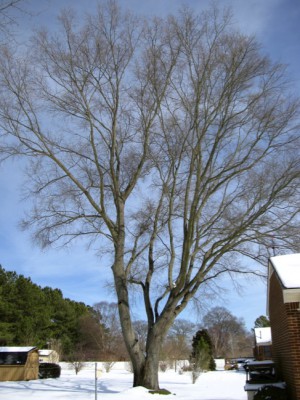Codominant stems with included bark are responsible for many of the catastrophic tree failures that litter our lawns and damage our homes after a wind storm. By recognizing visible defects prior to inclement weather, we can take corrective actions and preserve otherwise healthy trees.
What’s The Problem?

Mature willow oak with codominant stems
Many of our mature landscape trees were not pruned properly when they were young. The risk of failure of young codominant stems usually increases as the tree grows taller and more massive. We’ve all seen our local street medians littered with the broken stems of Bradford pears after a wind storm. The culprit? Included bark and codominant stems.
Pictured here are the codominant stems of a local willow oak; as the separate stems grow larger in girth, they will contact each other higher and higher, continually pushing against one another. The growth of the wood in each stem will have the mechanical effect of driving a wedge downwards between the two. Now imagine a sheet of plywood placed between the stems where they appear to be fused. The included bark is the mechanical equivalent of our imaginary plywood.
The precarious nature of this defect is obvious. The roots on the right side of our photograph are not anchoring the left stem and the roots on the left are not anchoring the right stem. Basically we have two trees, each with root systems that are biologically sufficient, but from a mechanical point of view they are inadequate.
Mitigating Codominant Stems
The pictured oak would not be standing today if the separate stems were not held together with a steel cable system. This tree cracked severely in Hurricane Isabel and would have completely failed had the owner not been prudent enough to tie the stems together immediately prior to the storm. After the hurricane, substantial pruning was performed on the left stem to reduce weight and a steel cable was installed.
Steel cables and bracing rods are not our only options in dealing with codominant stems. If there is no danger to any valuable targets, perhaps the tree can be pruned to reduce the risk of failure. Sometimes valuable targets can be moved. We can also install a less invasive (no drilling) dynamic poly-propylene cabling system, that will allow the tree to grow and flex normally while still reducing failure potential. Unfortunately sometimes the right choice is to remove the tree and eliminate the risk.
Our ISA Certified Arborists have the expertise to make the appropriate recommendations that will reduce the risk of tree failure and preserve your valuable trees. We are familiar with the common defects in our local trees, as well as their growth and strength characteristics.
If you’re unsure whether your trees are structurally sound, call or email us. Although many defects can be hidden from an untrained eye, we can show you what to look for and find a solution to mitigate most problems. If you maintain healthy, structurally sound trees, there’s no need to have irrational fears about tree failure.
